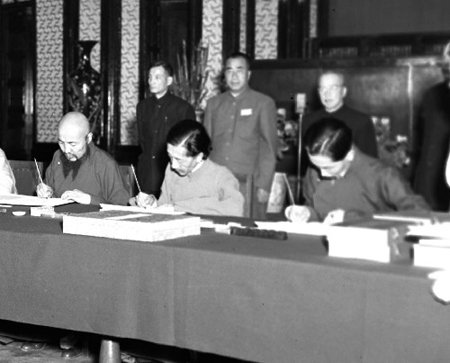
Delegates from Tibetan local government signed on the agreement, May 23, 1951. [File photo]
In April 1951, the local authorities of Tibet sent a plenipotentiary delegation led by Ngapoi Ngawang Jigme to Beijing for talks on the peaceful liberation of Tibet. On May 23, the "Agreement of the Central People's Government and the Local Government of Tibet on Measures for the Peaceful Liberation of Tibet" was signed, known for short as the "17-Point Agreement for the Peaceful Liberation of Tibet." The main contents: expelling imperialist forces out of Tibet; reorganizing the local Tibetan troops into the People's Liberation Army (PLA); exercising national regional autonomy in Tibet; carrying out gradual social reforms and implementing the policy of freedom of religious belief, among others. On October 26, the PLA entered Tibet and peacefully liberated the area.
Historical Background to the Peaceful Liberation of Tibet
At the end of 1949, the local authorities of Tibet, instigated by imperialist forces, attempted to obstruct the PLA entering Tibet to achieve "independence." To realize the unification of the country, the Chinese central government made the decision to peacefully liberate Tibet, and notified the Tibetan local authorities to send delegates to Beijing for negotiations. But the Tibetan side failed to fulfill these hopes. In early October 1950, the PLA entered Tibet and liberated Qamdo, creating favorable conditions for the peaceful liberation of the region.
(Courtesy of the Foreign Languages Press)
